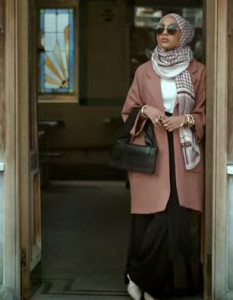H&M: Where Pseudo-Sustainability Meets Diversity Porn
by Melody Moezzi, MS Blog, September 30, 2015
The world’s second largest fashion retailer recently made a deliberate move to attract members of the world’s second largest religion, and people have taken notice.
More specifically, H&M featured a Muslim hijabi woman for a split second in this video advertising spot that deftly disguises a sly cost-saving measure as an eco-friendly call for “sustainable fashion.†The spot concludes, “Leave your unwanted garments in any of our 3,300 stores. We reuse them or recycle them into new clothes. Recycling one single T-shirt saves 2,100 liters of water.†Makes you wonder how much money it saves H&M—though unsurprisingly, the ad doesn’t say.
More notably, the ad includes a sort of festival of other “others,†resulting in an awkward spectacle of diversity porn that begs to be shared and tweeted by all those progressive and free-thinking folks who have no problem letting multinational companies into their hearts, minds and closets.
The H&M “Close the Loop†ad’s cast of characters is extensive, painfully contrived and devoid of context. Aside from the hijabi model, Mariah Idrissi, the short spot also features the following parade of corporately manufactured diversity:
Eleven Sikh men in multicolored turbans, a white woman over 40 who dares to wear a short skirt while lying on a bed with a blond black woman and reaching her arm out to a young tuxedoed white man sitting on the floor, an ethnically ambiguous man sporting a 5 o’clock shadow and a skirt, two black women in red hats, a trans woman in a drugstore aisle wearing ornate body armor, another trans woman looking at herself in the mirror, a full-figured white woman filling a parking meter while daring to mix red and pink, a couple of Latinas in black overalls and excess eyeliner sitting on a red sports car with palm trees and an RV parked in the background, a sheikh (or so the voiceover claims), a blond white woman wearing short shorts and a bustier as she poses unnaturally on top of a sink, a shirtless (and apparently commando) Iggy Pop holding a running garden hose, a boxer (human, not K9) with a prosthetic leg, and so much more.
Yes, it’s absurd. Yes, it’s random. And yes, it’s calculated. Like any shrewd retailer, H&M wants you to buy their products, no matter your race, religion, size, age or gender identity. While I strongly support more and better media representations of Muslims, Sikhs, members of the LGBT community, older women and people of color, I’m not about to commend H&M here. For one, their most prominent ads still tend to feature unnaturally thin white women.
More importantly though, squeezing as many minorities as possible into a single one-and-a-half-minute clip full of badly executed stereotypes is not an ideal way to go about promoting genuine diversity or acceptance. If anything, such tactics tend to further otherize and exoticize members of the different minority groups represented by lumping them all together and limiting their inclusion elsewhere amid the majority.
Listening to the ad’s creepy voiceover (courtesy of Iggy Pop), I noticed the single hijabi model is linked to the term “chic,†while the white woman posing on top of a sink (sex blogger Karley Sciortino) is linked the term “liberated.†While the Muslimah may in fact look chic, the white woman doesn’t look all that liberated, given her shorts and bustier appear to restrict healthy circulation.
All this to say, I highly doubt H&M has any interest in true diversity or feminist liberation. H&M is a multinational company, and its interest is in maximizing profits. If you don’t believe me, just ask Human Rights Watch or any of the Cambodian women or children H&M has employed for next to nothing.
As a Muslim woman who chooses not to wear hijab, I maintain great respect for my Muslim sisters who do wear it, whether they’re models or not. For many Muslimahs who choose to cover their hair, the hijab is not simply a symbol of modesty or piety, but a symbol of feminism itself—a concept brilliantly related by writer Hanna Yusuf in this video blog for The Guardian.
Feminist hijabi women like Hanna are not just opting out of rigid Western standards of beauty by choosing to cover, many are also opting out of the consumerist culture that perpetuates such standards. This powerful act of resistance threatens advertisers and corporations that rely on their constructed notions of beauty—often based in perceived heterosexual male fantasies—to sell all sorts of products. For that revolutionary act alone, I have to give a loud shout-out to those of my hijabi sisters who have refused to be complicit in the blatant commodification of our bodies and the corporate infiltration of our minds. We may not choose to fight this fight in the same way, but there is no doubt that we are in it together.
Melody Moezzi is a writer, activist, attorney and award-winning author. Her latest book, the critically acclaimed memoir Haldol and Hyacinths: A Bipolar Life, was recently released in paperback.
